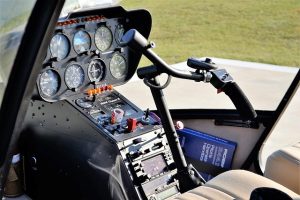
If you’ve ever peeked into the cockpit of a helicopter, you may have noticed that it didn’t have a yoke or side stick. Yokes and side sticks are found in airplanes. Helicopters, on the other hand, have a cyclic. What is a cyclic exactly, and what purpose does it serve?
Overview of Cyclics
A cyclic is a joystick-like control stick that determines the direction in which a helicopter flies. It’s manually operated with one hand. Pilots can move the cyclic forward, backward, left or right to fly the helicopter in that direction.
Most helicopters have one cyclic per pilot. In a typical dual-pilot setup, there are two cyclics. They are typically located directly in front of the pilots’ seats.
How Cyclics Work
Cyclics work by controlling the tilt of the helicopter’s main rotor disc, which in turn changes the direction in which the helicopter flies.
Within a helicopter’s control system is a device that converts mechanical cyclic input into changes in the rotor’s angle of attack. Known as a swashplate, it automatically adjusts the angle or tilt of the main rotor disc. When a pilot moves the cyclic, the swashplate will move in that direction as well. The rotor’s pitch will essentially increase on one side of the rotation and decrease on the opposite side, resulting in uneven lift that moves the helicopter in the appropriate direction.
Helicopters don’t move instantly in response to cyclic input, though. Instead, the main rotor disc will tilt, resulting in a change of lift. The helicopter will then begin to move in that direction.
How Cyclics Differ From Yokes and Side Sticks
Cyclics aren’t the same as yokes and side sticks. Yokes and side sticks are found in airplanes, whereas cyclics are found in helicopters. Cyclics typically consist of control sticks that look like a joystick. Yokes, in comparison, are U-shaped control wheels, whereas side sticks are shorter joystick-like control sticks.
Yokes and side sticks are used to operate an airplane’s control surfaces, such the ailerons on the wings and the elevator on the tail. Cyclics are used specifically to change rotor’s angle of attack.
Cyclics must also be constantly adjusted. Pilots must keep their hands on the cyclic at nearly all times to ensure safe and stable flight. Yokes and side sticks, though, don’t require constant adjustment. Pilots can engage the trim tabs to stabilize the airplane. These are just a few ways that cyclics differ from yokes and side sticks.



